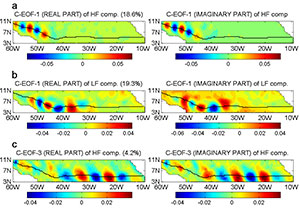Interannual and regional circulations in the Tropical Atlantic Ocean using satellite data and complex systems modeling

Author:
Sabine Arnault - (LOCEAN)
Co-Investigator(s):
Angora Aman (LAPA)
Anastase Charantonis (LOCEAN)
Mbaye Babacar Gueyeœ (UCAD)
Jean-Luc Melice (LOCEAN)
Awa Niang (LTI)
Sylvie Thiria (LOCEAN)
Abstract:
The tropical Atlantic Ocean variability is complex. It has benefited from previous investigations using large scale altimetry so that the knowledge of the seasonal signal of the oceanic circulation has been improved.
With nearly 30 years of data, satellite altimetry offers a unique opportunity to investigate the interannual variability with much more precision on ocean dynamics. With the arrival of a new generation of altimeters dedicated to the coastal environment, SARAL/Altika and future SWOT missions, regional impacts can also be identified and followed.
At the same time, numerical and mathematical concepts have been developped in order to extract the different components of a weak (compared to the seasonal one) signal
In this proposal, our objectives are to take benefits from these developments and apply them to the altimetry series, together with in situ data sets (Argo floats for instance), other satellites informations (SMOS Sea Surface Salinity, recomposed Sea Surface Temperature, or Ocean Color) in order to progress in the knowledge of the low frequency variability in the tropical Atlantic Ocean. Besides basin wide study, we will focus on particular areas of interest such as the Western North Brazil Current and North Equatorial CounterCurrent regions, and the Gulf of Guinea.
